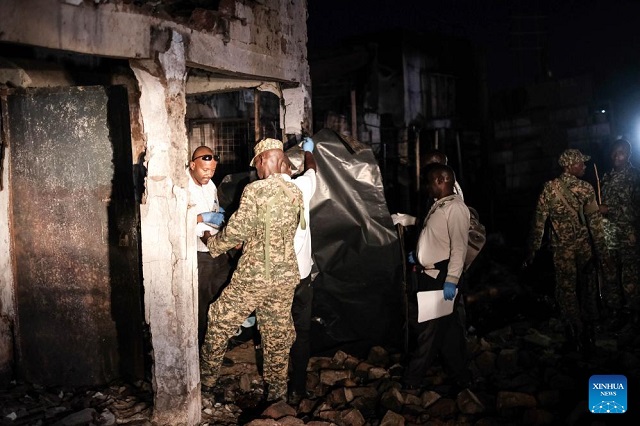
WAKISO, UGANDA | THE INDEPENDENT | When an incident happens to or at a property and there are spillover impacts to neighbouring properties and/or human lives, there may be questions unanswered as to where to seek redress, if any.
These may be a building, finished or under construction, collapsing or a fuel tanker catching fire and the impact affects third parties.
Similarly, shop owners and other business and property owners, as well as the injured and bereaved were left wondering what next after a fuel tanker caught fire at Kigoogwa along Kampala-Bombo Road in Wakiso District on October 22.
First, assuming the truck was not insured, then it would be a purely legal issue, with victims trying to force compensation orders from courts of law, first against the fuel tanker owner.
If there was negligence on the part of the local authorities leading to the accident or failure to mitigate the damage, there would also be legal action against them.
In other jurisdictions, the fire department, government ambulances or health facilities may be liable if it is proved that the deaths of the injured were a result of their inefficiency or negligence.
Could this be the reason governments immediately offer “help with medical bills and burial expenses”?
When a fuel tanker is insured comprehensively, the insurance policy typically covers damage to the vehicle itself, as well as certain third-party liabilities.
However, the extent to which the insurance company will cover liability depends on the specifics of the insurance policy and the jurisdiction.
According to Mayfair Insurance Uganda property damage liability coverage pays for any damage to the property of others up to the stated amount provided by the policy (like a crushed fender, broken glass, or a damaged wall or fence).
“Your insurance will pay for this damage if you or another person with your consent were driving your auto. Property damage liability also pays if you damage government property like a light pole or signpost, up to the limit you choose,” says Mayfair.
Assuming the Kigoowa incident truck was insured comprehensively, there are options for third-party damages, according to experts.
Comprehensive insurance often includes third-party liability, which means damage to other people’s property (such as homes, shops, or other vehicles) caused by the accident may be covered.
But there are limitations.
The liability can be shared among multiple parties, considering the comprehensive insurance coverage and the severity of the incident, including the truck operator or owner, who may be primarily responsible for the damages and losses caused by the fire.
However, if there is comprehensive insurance for the truck, the insurance policy may cover damages to the truck itself, but it may also provide liability coverage for third-party damages, including property damage to homes and shops, bodily injury and fatalities.
However, the policy holder should discuss with the insurance company, what the policy they are holding or buying entails, because similar policies may have different extra clauses to the advantage of either the holder or the insurer.
Veteran Insurance agent and writer, Neil Marcus, says insurance companies rely on finding out how much the policyholder contributed to a loss-causing incident, for example when one’s vehicle catches fire and the fire damages other properties.
“That all depends on [why] your car caught fire. If something in your car spontaneously caught fire, and another car was damaged, then your Property Damage Liability will pay for the damage to the other car(s),” he says.
If the vehicle was set on fire by a malicious person, and as a result, the car next to it also was damaged, the liability would be on the person who started the fire.
“Other circumstances would be on a case by case basis, if something you did, or your car, then you are responsible, if outside forces started the fire, then you aren’t responsible.”
In the case of the Kigoowa incident, where the fuel truck caught fire, and damaged nearby properties, the victims (who are now third-party property owners) can file claims against the Motor Third Party Policy for property damage, bodily injury or death (if applicable).
However, in claiming or anticipating a claim, there are key considerations to make, including Policy limits, where claims are limited to the policy’s specified amounts.
There is also a need to check if the policy excludes damages caused by fire or specific types of accidents, and also find if there are “deductibles” (the amount of money that the insured person must pay before their insurance policy starts paying for covered expenses).
The usual process involved in claims applies where the victims file claims with the insurance company and allow time for the insurance company to investigate and assess damages, to determine the limits of the policy.
In many cases, the Motor Third Party amount offered is less than what is adequate to cover the damage or loss. If the Motor Third Party policy limits are exceeded or the insurance company disputes claims, the victims may sue the truck owner or operator personally, and seek further compensation from other potentially liable parties like the truck’s maintenance company.
However, the laws and regulations governing Insurance Policies vary from country to country.
The Insurance Regulatory Authority of Uganda gives guidelines on how much one can claim as a minimum, depending on the type of vehicle and the affected persons.
If the comprehensive insurance policy includes third-party bodily injury or death coverage, the insurer may pay for medical costs, funeral expenses, and other damages for the people affected.
As with property damage, there is usually a maximum limit for bodily injury or death.
The comprehensive insurance policy’s limits would determine the extent of coverage for third-party damages.
If the damages exceed policy limits, the truck owner/operator might be personally liable for the excess amount.
The fuel itself is treated as a hazardous material and insuring it may attract additional costs, or else, an ordinary comprehensive insurance policy may not cover the resultant Environmental and Hazardous Material Liability.
****
URN
 The Independent Uganda: You get the Truth we Pay the Price
The Independent Uganda: You get the Truth we Pay the Price



